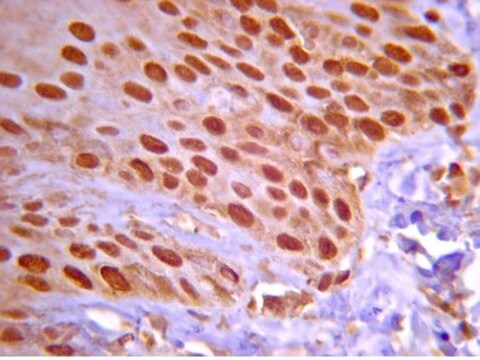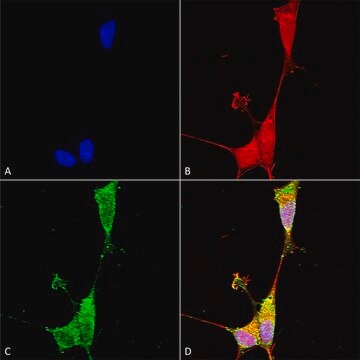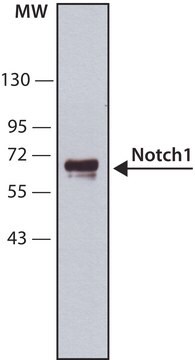07-1232
Anti-Notch 1 Antibody, NT
serum, from rabbit
Synonyme(s) :
Neurogenic locus notch homolog protein 1 precursor, Notch (Drosophila) homolog 1 (translocation-associated), Notch 1, Notch homolog 1, translocation-associated (Drosophila), Translocation-associated notch protein TAN-1, Neurogenic locus notch homolog pro
About This Item
Produits recommandés
Source biologique
rabbit
Niveau de qualité
Forme d'anticorps
serum
Type de produit anticorps
primary antibodies
Clone
polyclonal
Espèces réactives
human, mouse
Réactivité de l'espèce (prédite par homologie)
rat (immunogen homology)
Technique(s)
ELISA: suitable
immunohistochemistry: suitable (paraffin)
western blot: suitable
Isotype
IgG
Numéro d'accès NCBI
Numéro d'accès UniProt
Conditions d'expédition
wet ice
Modification post-traductionnelle de la cible
unmodified
Informations sur le gène
human ... NOTCH1(4851)
Description générale
Spécificité
Immunogène
Application
A previous lot of this antibody was diluted to 1:20,000-1:60,000 and used in a standard sandwich ELISA assay against the peptide immunogen.
Immunohistochemistry(paraffin):
Representative testing from a previous lot.
Optimal Staining of Notch-1 With Citrate pH 6.0 Epitope Retrieval: Uterine Cancer
ELISA: A previous lot of this antibody was diluted to 1:20,000-1:60,000 and used in a standard sandwich ELISA assay against the peptide immunogen.
Epigenetics & Nuclear Function
Transcription Factors
Qualité
Western Blot Analysis: 1:500 dilution of this lot detected cleaved NOTCH1 on 10 μg of Jurkat lysates.
Description de la cible
Liaison
Forme physique
Stockage et stabilité
Handling Recommendations: Upon first thaw, and prior to removing the cap, centrifuge the vial and gently mix the solution. Aliquot into microcentrifuge tubes and store at -20°C. Avoid repeated freeze/thaw cycles, which may damage IgG and affect product performance.
Remarque sur l'analyse
Jurkate Cell Lysates. In fetal tissues, use spleen, brain stem and lung. In adult tissues use mainly lymphoid tissues.
Clause de non-responsabilité
Vous ne trouvez pas le bon produit ?
Essayez notre Outil de sélection de produits.
En option
Code de la classe de stockage
12 - Non Combustible Liquids
Classe de danger pour l'eau (WGK)
WGK 2
Point d'éclair (°F)
Not applicable
Point d'éclair (°C)
Not applicable
Certificats d'analyse (COA)
Recherchez un Certificats d'analyse (COA) en saisissant le numéro de lot du produit. Les numéros de lot figurent sur l'étiquette du produit après les mots "Lot" ou "Batch".
Déjà en possession de ce produit ?
Retrouvez la documentation relative aux produits que vous avez récemment achetés dans la Bibliothèque de documents.
Notre équipe de scientifiques dispose d'une expérience dans tous les secteurs de la recherche, notamment en sciences de la vie, science des matériaux, synthèse chimique, chromatographie, analyse et dans de nombreux autres domaines..
Contacter notre Service technique








